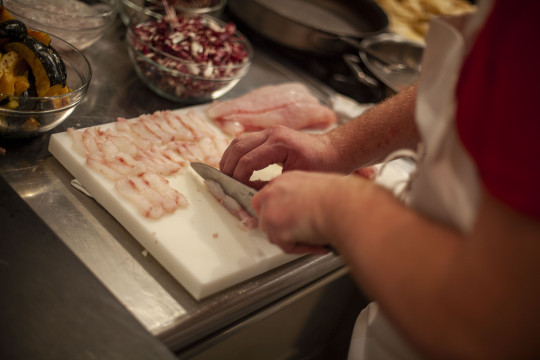‘Tis that time of the month again. While the weather hasn’t exactly been wintry yet, December’s classes were ready to delve into the heavier side of cooking. With hearty, soul-warming dishes, our guest chefs treated patrons to the coma-inducing meals meant to encourage hibernation. Read on for our favorite tips from the last month.
Every day we’re sproutin’…

Craig Meyers of Rex
A few years ago, brussels sprouts made their comeback. Everyone was doing their best to come up with their own interpretation of the little green dynamos. You might find some general commonalities though. Obviously, find your favorite fat. Add kosher salt to taste. You’re likely to see a vinegar of some type. This was the case for Craig Meyers of the new iteration of Rex. You want to start by halving the sprouts, and after pan roasting them with butter, he tossed them in a herbed honey vinaigrette.
Herbed Honey Vinaigrette
1 gallon apple cider vinegar
4 large shallots, sliced
1 bunch thyme, tied
1 bunch rosemary, tied
1 cup honey
Add all of the ingredients into a 8-quart sauce pot and simmer until reduce by half. Cool and mix with 1 part to 1 part olive oil.
Maybe it was a fluke

Mark Regan of Messina Social Club
If you’re a lover of the raw, always ordering sushi can be an expensive endeavor. For your next get together, why not find yourself an interesting and fun alternative? Fluke, the bottom-dwelling flatfish from the North Atlantic, is a mild-flavored white fish that presents a relatively easy opportunity to test your skinning skills. Make sure you have a sharp knife and start your cuts in the middle. As you see with Mark Regan of Messina Social Club, you’ll find a simple starting point along the spine. From the spine, you’ll find the other bones extending towards the far edge of the body. Take your knife and run along those bones to detach the filet. From there, flip the piece with the skin facing down and start to detach the scales from the flesh. Slice thinly. You can either eat this without any adoration or dress with citrus, olive oil, and sea salt for a simple crudo.
Entertainer Supreme

Becca O’Brien of Two Birds Catering
There’s a reason why people go to restaurants and want to order “drinks and apps.” First, they don’t want to commit to dinner with their first date. Secondly, maybe they’re just not hungry. Another reason, it’s a great way to try a few different bites. One staple of appetizer menus across America is the spinach artichoke dip. Some versions have a little sharpness, some are creamier, etc. Becca O’Brien‘s might be all the above.
Spinach Artichoke Dip
10 oz package frozen spinach or 1.5 lbs blanched fresh spinach
2 cans whole artichoke hearts, rough chopped
1 package cream cheese
5 cloves roasted garlic
1 leek, cleaned and roasted
4 oz mozzarella cheese
2 oz parmesan cheese
parsley, sage, rosemary, thyme and oregano (fresh or dried, just a pinch, to taste)
salt and pepper
Preheat oven to 375. In a food processor, place garlic, 1/2 the roasted leeks and puree until smooth. Add cheeses and salt and pepper and herbs and puree. Add spinach and pulse until combined. Remove from the processor and fold in artichoke hearts and remaining leeks. Check for seasoning. Place into a small baking pan/casserole and cook until hot and bubbly. Serve.
Mulling It Over
A traditional winter German beverage, glühwein should be a staple in everyone’s house this time of year. Not familiar with the concept? Think sangria but warm. Sounds great, right? When Meredith Rebar of Home Brewed Events stopped by for her Belgian beer class, she brought the lovely spiced treat that originated in Deutschland. If you want to try and make your own, follow these simple steps.
- Find a neutral wine. Something that is more fruit-forward and lower in tannins. Think typical merlot, pinot noir, grenache but keep in mind that wine expression can vary from producer to producer. So ask your local wine merchant.
- Take baking spices (cinnamon, clove, nutmeg, star anise), orange peel and add to a sauce pan with the wine. You’ll only need one, maybe two of each per bottle.
- Turn the heat on medium-low. Bring to a simmer, be careful not to boil. Once it starts bubbling, turn off and serve.
Southern Hospitality

Want an unexpected addition to a dish? Infuse! Maybe not in the way you’re thinking though. We often see sides like “mushroom risotto” on menus and it is as simple as cooking said item (mushrooms in this case) and then folding it into the traditional item (risotto). You can do this almost any time you deal with risotto, rice, or grits. Being a Southern boy, playing with grits seems sacrilegious (looking at you, sugar people). Our friend Malik Ali likes adding ingredients to the creamy grain and I couldn’t be happier to be more wrong. Simply take a traditional grit recipe (1 cup of grits, 2 cups of water, 2 cups of milk, a pinch of salt) and cook as normal. Whatever you’re thinking of adding, you will need to cook on its own, puree it, and simply fold it into the pot with the finished grits. You’ll want to prepare the add-on as if it were a standalone dish though. In this case, Malik cooked the sweet potatoes and added maple syrup, butter, and salt to the blender to finish.
The Long and Short About Rice

Rice is a staple in many cultures. For as many regions that use rice, there are that many species. For Rupen Rao, there is only one choice for him and that’s supreme basmati. If you want to master this long grain, start with adding 2 cups rice in a medium mixing bowl. Add 2 cups water, mix, rinse, and drain. Repeat this 2 more times, and make sure you are not wasting a single grain of rice in this process. Set aside for 20 minutes. In a 5 qt wide bottom sauté pan, add 4 cups water and add the soaked rice. Over high heat, bring it to a boil. Once the water comes to a boil, reduce heat to simmer and cover and cook rice for 12 minutes or until all water has been absorbed by the rice. Rice should be completely cooked, fluffy and long. Let this rice rest (covered) for 15 minutes and serve!
Happy cooking. See you in 2020!
Back to Blog



